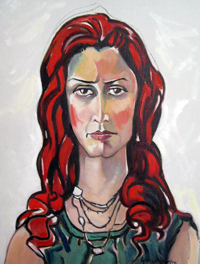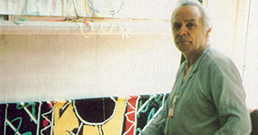The Art of Marco Grigorian
12.9.2012
Marco Grigorian, modern painter, sculptor, collector, pianist, actor and carpet weaver was born in Russia in 1925. His family had migrated from present day Turkish city of Kars. In 1930, the family left Russia for Tabriz and later Abadan and Isfahan where Marco started his early education. He went to an art school in Tehran and later he studied at the Accademia di Belle Arti in Rome. In 1954, he returned from Rome and opened the Galerie Esthetique in Tehran.
In 1958, he organized the first Tehran Biennial where artworks by modern artists were displayed thus playing a role in introducing and promoting modern art in Iran. He also helped to introduce the works of prominent Qahve-khaneh or teahouse painters such as Hossein Qollar-Aqasi and Mohammad Modabber to a wider public in Tehran.
Marco’s work with clay and straw and earth-ware became a pioneering genre. In 1970 Grigorian started teaching at the University of Tehran’s Fine Arts College. He became an influential teacher and taught many prominent artists in this period.
In 1975 Grigorian with Gholamhossein Nami, Masoud Arabshahi, Morteza Momayyez and Faramarz Pilaram, organised “the group of free painters and sculptors” in Tehran. After the revolution he left for New York where he opened a gallery to display his work and his major collection of art. In 1989, he traveled to the USSR visiting Moscow, Leningrad and Yerevan, where he took up residence and set up a museum with his works of arts and collections. He exhibited his clay and straw works in Yerevan in 1991. Some of his works are now on display at the Museum of Modern Art in New York, Tehran’s Museum of Contemporary Art, the Museum of Contemporary Art in Kerman, and the Armenian National Gallery. He died on 27th August 2007.
Marco’s Inner World and Inner Reflection
Dr Yvette Tajarian
(Academic and Art expert, Yerevan)
As a representative of modern art Marco has a special place in the history of Art. After a short encounter with Marco, anyone could tell that he was a true artist. His artistry could be observed not only in his creative genres – paintings, Earth works, Land art and carpet making, but also in himself as an outstanding artist. Marco displayed his brilliant individuality in each genre, but in my opinion, it was the Land art that became his “business card”. The painter turned simple earth into artistic value. Placing earth in a square frame, turning it into an object of reflection, he stopped it from being just a piece of earth and helped it to acquired artistic value. The geometrical square reflects the environment, shelter, while the content of the frame encompasses the eternity and timeless preservation. Man was created from the earth, lives on earth and creates works about earth. Having physical and spiritual significance, the first parallel that is related to the earth is the homeland, where each individual stands firm on the land. It can be assumed that Marco is trying to bring forward a sense of security in an individual, attempting to convey life and fate to the earth. One can see the inner strength that has led Marco towards creation of land art. It is conditioned by his homeland being under the rule of foreigners, as well as the author himself living and creating on a foreign land.

Yvette Tajarian
Marco who was aiming for innovation found a new sphere for the expression of his interests - the carpet: carpet-weaving and carpet painting. These are different fields which synthesize art and craft, interweaving and becoming a very important phenomenon of art, the art of carpet-making.
In Marco’s words, the idea of carpet painting and carpet-weaving was conceived in 1957, when he was drawing a small goat for his daughter Sabrina with colourful pencils. The little goats that he painted for his daughter led to a series. From these drawings of the goats he created a number of compositions that were inspired by cave art. Marco studied both Persian and Armenian histories of carpet, but as a result he created an ‘independent’ series of carpets characteristic only to him. The names of the carpets are Armenian, however the interpretation of lines are free, unconfined as if floating on the carpet. The sketches of carpets enrich the understanding of the art of Armenian national carpet-making and enlarge the circles.
As a result, the carpets of the artist are considered to be “Modern Armenian carpets”. And this characterises Marco Grigoryan as an individual. No Armenian had ever dared to put aside the Armenian traditional carpets with ethnic elements and create a new one. It requires courage and responsibility.
Marco was able to also synthesize the old with the new one. He gave modern solutions to historical subjects. Each of them undergoes his own interpretation. After all, Marco does not impose his thoughts. He gives an option, which does not have an end.

Yvette Tajarian's portrait
In painting, Marco presents himself with powerful brush strokes. In his early works one notices the elements of cubism. The sources of inspiration in the works of that period are different – landscape, portrait and sometimes imagination. The colours are comparatively more vivid, dense and polychromatic. Sometimes dark colours come into scene. In the earlier period we come across sketches more frequently.
A great example of Marco’s creative life is his work “The Gates of Oświęcim” (Auschwitz), one of the most horrendous Jewish slaughterhouses of Nazi Germany. Marco forces the viewers to get away from the present and revisit the tragedy. It seems to be a way of sobering oneself, which is brought forward in the painting by Marco. He tries in every way to keep the humanity away from the possible tragedies. This can be noted not only through strong and firm lines, but also the big sizes and the quantity. Thirteen canvases with their tragic march have a beginning and an end. In the last 13th canvas the ashes turn into earth, heralding the continuation of life.
For painting portraits Marco had a very interesting approach in choosing the model. Not everyone could earn the honour to become one. These were mainly people that surrounded him, but in his own words “people that had something to say”. He was interested in the inner beauty rather than the outer. The colours in the portraits that he painted during the last 20 years are softer and more natural. The background is often devoid of any colours. In my opinion, he has tried to draw attention to the portrait only. These are more expressionistic works. He expressed people on canvas the way he saw them. I remember how he told me laughingly that he used to have quarrels with beautiful women after he would paint them. He used to tell me they did not understand art. Women wanted to see themselves more beautiful and since during the process of painting he did not allow them to see the canvas, seeing their curvy and crooked characters in the end made them feel offended. It was very difficult for Marco to let go his canvases and his works in general. He wasn’t very lavish either, and rarely gave the paintings to the models; however in my case I was lucky. During the last 3 years of his life he had not painted any works and every time he saw me he used to say “I have to paint you…”. One month before his death, when he was at home in the evening he asked me to come the next morning so that he could paint me. I had certainly waited for that day for a long time. He painted me for 1 hour and 40 minutes during that hot summer. I was very happy that day, but was surprised once I had seen the painting. He said that this was the Yvette that he knew – serious, demanding, struggling and achieving her aims. He added in the end, “I will name this painting Saint Mary”. I laughed and asked who has seen St. Mary with red hair? He answered saying, “My Saint Mary has red hair.” This was Marco “the crazy artist”. No one took offence from his craziness, because he was loved just the way he was. He was 82 years old, but he was not ageing. He was always in the centre of attention, especially women’s, and he liked it. He knew his worth; he knew he was handsome and attractive. He did not believe that he was mortal and that he would also have his ‘end’. But that ‘end’ came to his physical existence not his works of art. His work is alive and can speak. It lives and will live on, and through them – Marco.


